Main menu
Common skin conditions

NEWS
Join DermNet PRO
Read more
Quick links
Authors: Dr Amanda Oakley, Dermatologist, Hamilton, New Zealand, 2001; Updated: Dr Christine Condon, Resident Medical Officer, St Vincent’s Hospital Melbourne, Australia; A/Prof Rosemary Nixon AM, Dermatologist, Skin Health Institute, Carlton, Australia. Copy edited by Gus Mitchell. March 2021
Introduction
Demographics
Causes
Clinical features
Variation in skin types
Complications
Diagnosis
Differential diagnoses
Treatment
Outcome
Appendix: list of causes
Fixed drug eruption is a distinctive cutaneous allergic reaction that characteristically recurs at the same site(s) on re-exposure to the medication or other chemical agent.

Fixed drug eruption
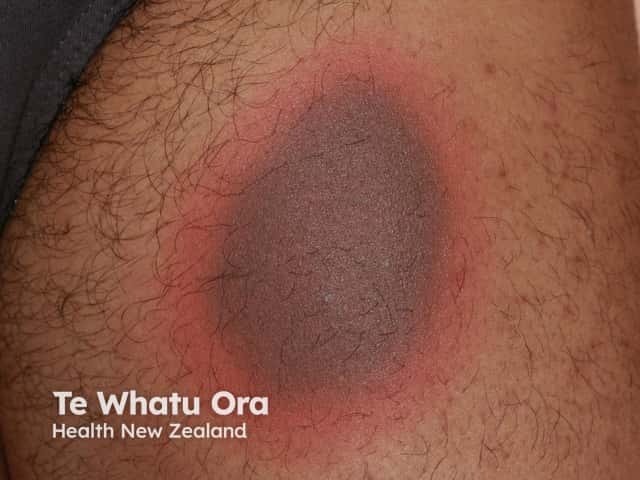
Targetoid fixed drug eruption
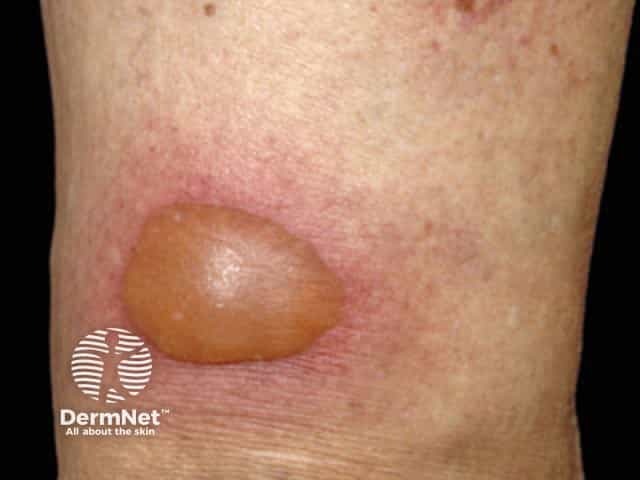
Blistering fixed drug eruption
Fixed drug eruption affects both sexes, and affects adults more commonly than children. There are some examples of HLA-associations with fixed drug eruptions due to specific drugs eg, HLA-A30 with cotrimoxazole-induced fixed drug eruption.
Fixed drug eruption is a delayed type IV hypersensitivity reaction. In the initial phase memory CD8+ T-cells at the dermo-epidermal junction release interferon-gamma when activated by the medication antigen causing epidermal basal layer damage. Recruited T-cells and neutrophils damage melanocytes and keratinocytes. During the resolution phase, dermal macrophages collect the melanin resulting in the typical post-inflammatory hyperpigmentation. Regenerating basal keratinocytes release interleukin-15 leading to the formation of resident memory CD8+ T-cells which remain quiescent but in a primed state ready to respond to the chemical antigen again.
Fixed drug eruption is usually due to oral medications, with antimicrobials and non-steroidal anti-inflammatory drugs (NSAID) being the most common culprits. Less common drug exposures may be topical or intravaginal. Fixed food eruptions may be due to antibiotics, flavouring or colouring agents, or preservatives in the food. Herbal supplements and caffeine have also been implicated. For a more detailed list, see the Appendix at the end.
Fixed drug eruption can be categorised by clinical morphology. The most common form is the localised pigmenting type; other presentations include bullous (localised or generalised), mucosal, non-pigmenting, or generalised.
Fixed drug eruption typically presents as a single (or small number of) well-defined, round or oval red or violaceous patch or plaque which may blister or ulcerate. It is usually asymptomatic but can be itchy or painful. Over the next few days and weeks, the surface may become scaly or crusted before peeling, and the colour fades to leave brown post-inflammatory hyperpigmentation. Post-inflammatory hyperpigmentation tends to be more prominent in skin of colour.
In contrast to many other drug eruptions, the patient remains systemically well.
The hands and feet, eyelids, and anogenital areas are common sites. Lesions in the oral mucosa are usually found on the lips, tongue and hard palate. A fixed drug eruption may occur at the same location as previous skin trauma such as a burn, insect bite, or venepuncture.
On the first occasion, the eruption may develop after weeks to years of regular ingestion of the drug, but subsequent episodes develop within minutes to hours of recommencing the implicated drug. A patch of fixed drug eruption shows a refractory period during which it will not flare even with re-exposure. With subsequent episodes, the original patch may enlarge and more patches may appear. The post-inflammatory hyperpigmentation darkens with each recurrence.
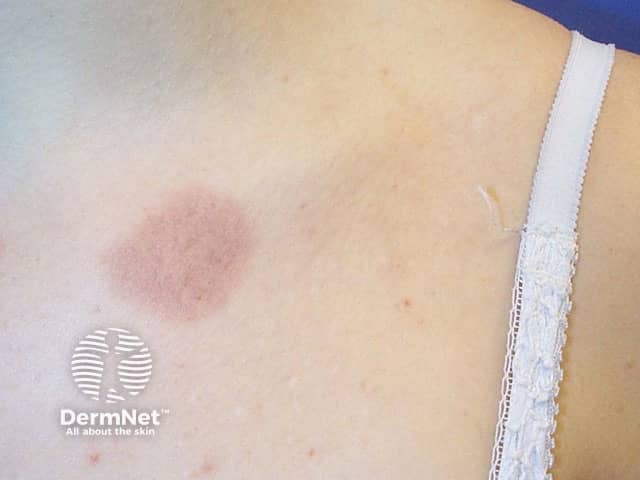
Fixed drug eruption
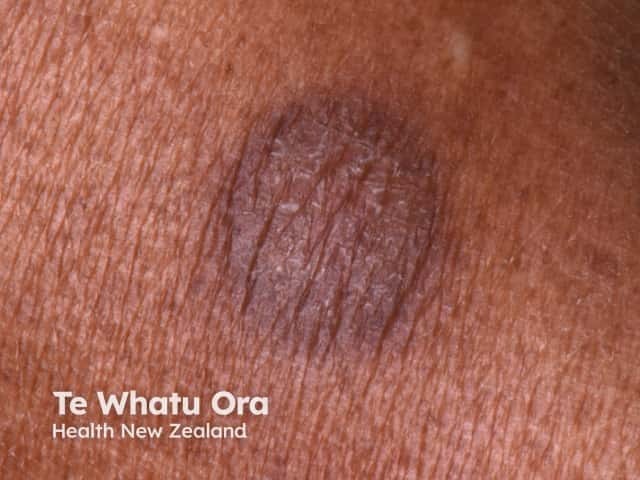
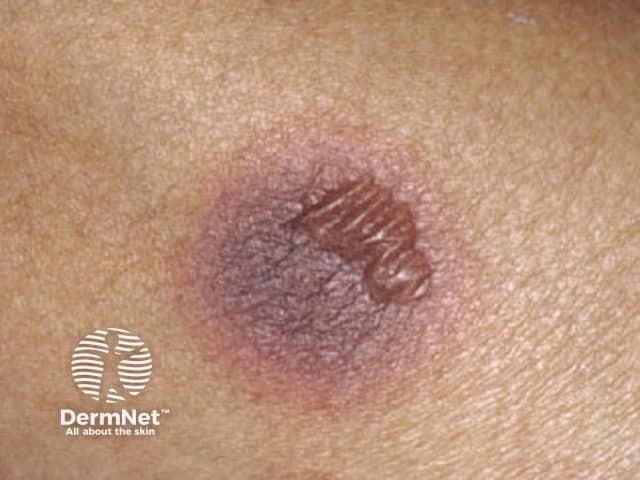
Targetoid lesion in fixed drug eruption
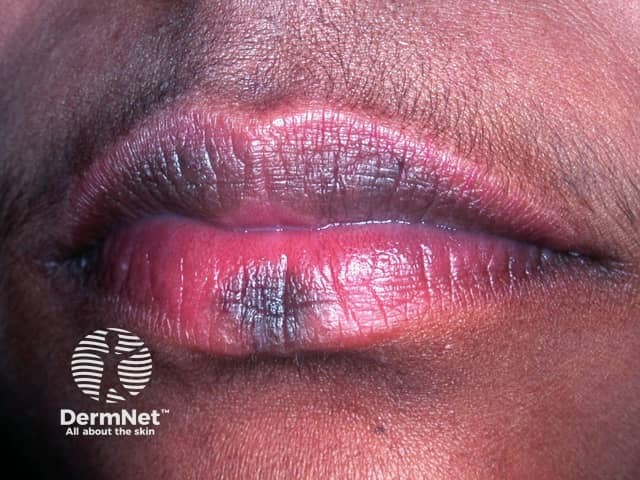
Pigmented fixed drug eruption on the lip

Ulcerated fixed drug eruption, oral mucosa

Fixed drug eruption: glans penis
Fixed drug eruption should be considered on history and examination but may be difficult on the first occasion. On subsequent episodes, a detailed history of oral intake in the preceding 24 hours may identify the culprit.
Investigations may include:
Fixed drug eruption is generally a benign self-resolving eruption that recurs on re-exposure, leaving post-inflammatory hyperpigmentation. Subsequent flares can be more severe.
Generalised bullous fixed drug eruption can be life-threatening, and has been reported to have a 20% mortality rate.
Carbamazepine, barbiturates, and benzodiazepines
Cetirizine, omeprazole, pseudoephedrine, sulphasalazine, vaccinations
Including traditional herbal medications and supplements
Asparagus, cashew nuts, kiwi fruit, lentil, palm wine, peanut, propolis, quinine (tonic water), seafood, strawberry, tartrazine (yellow rice, cheese crisps)